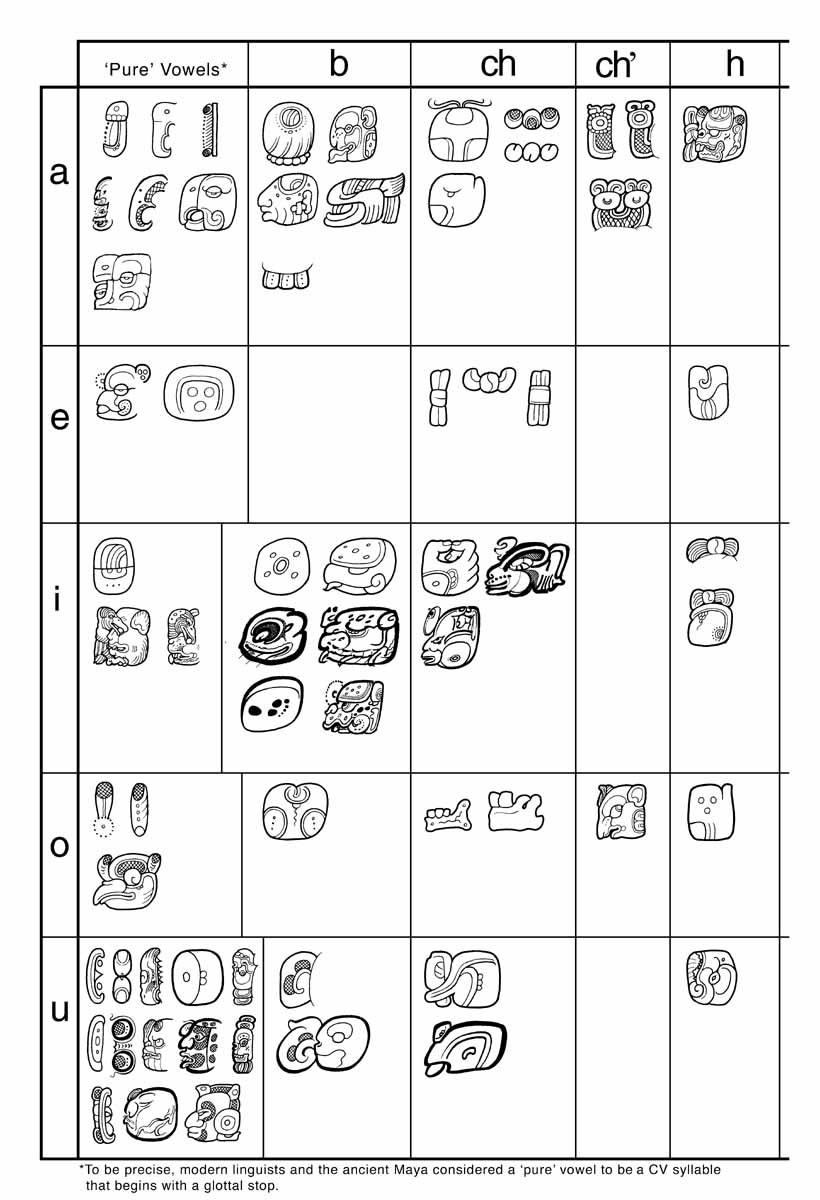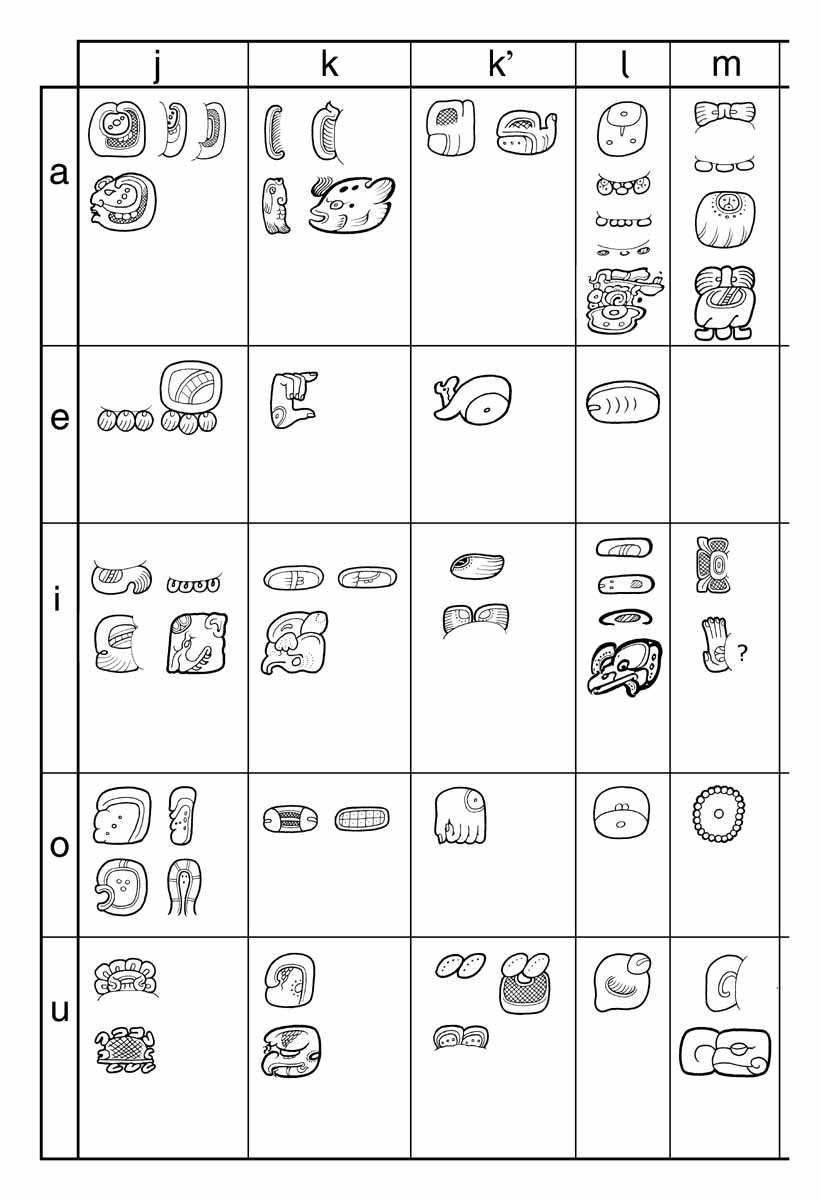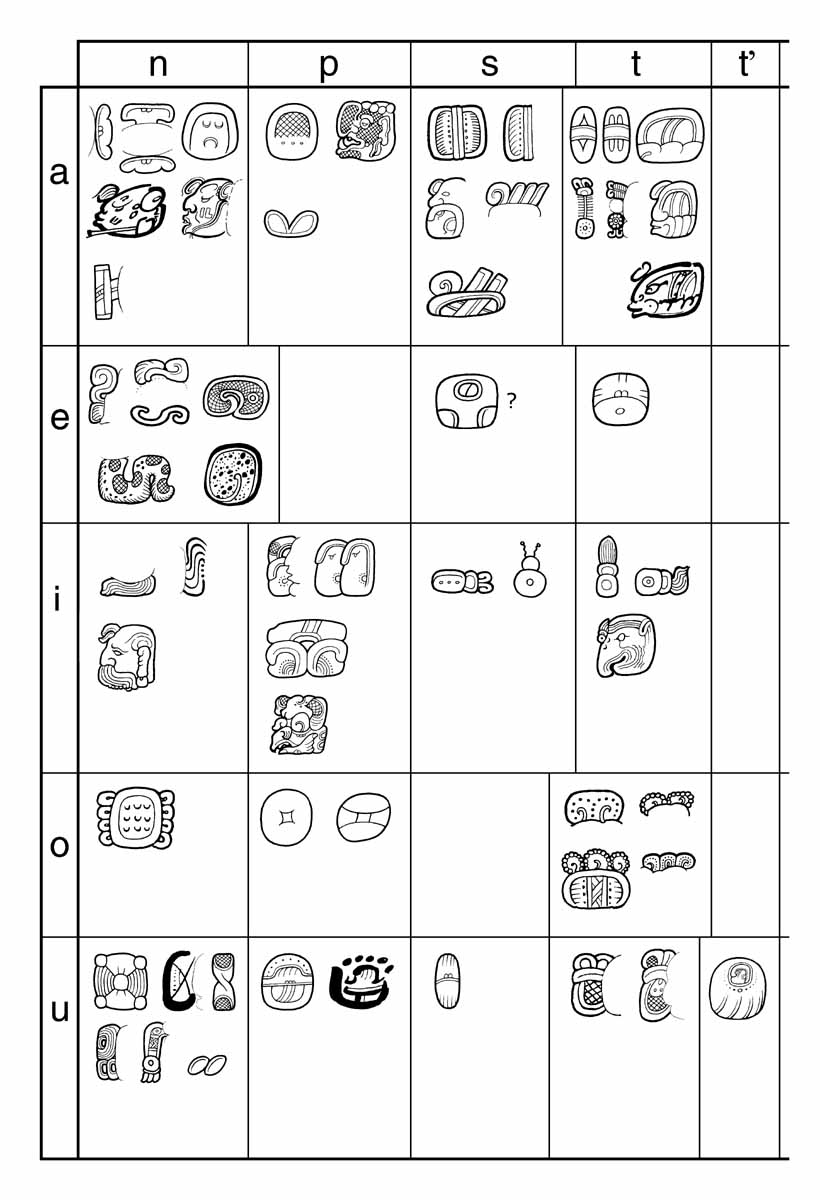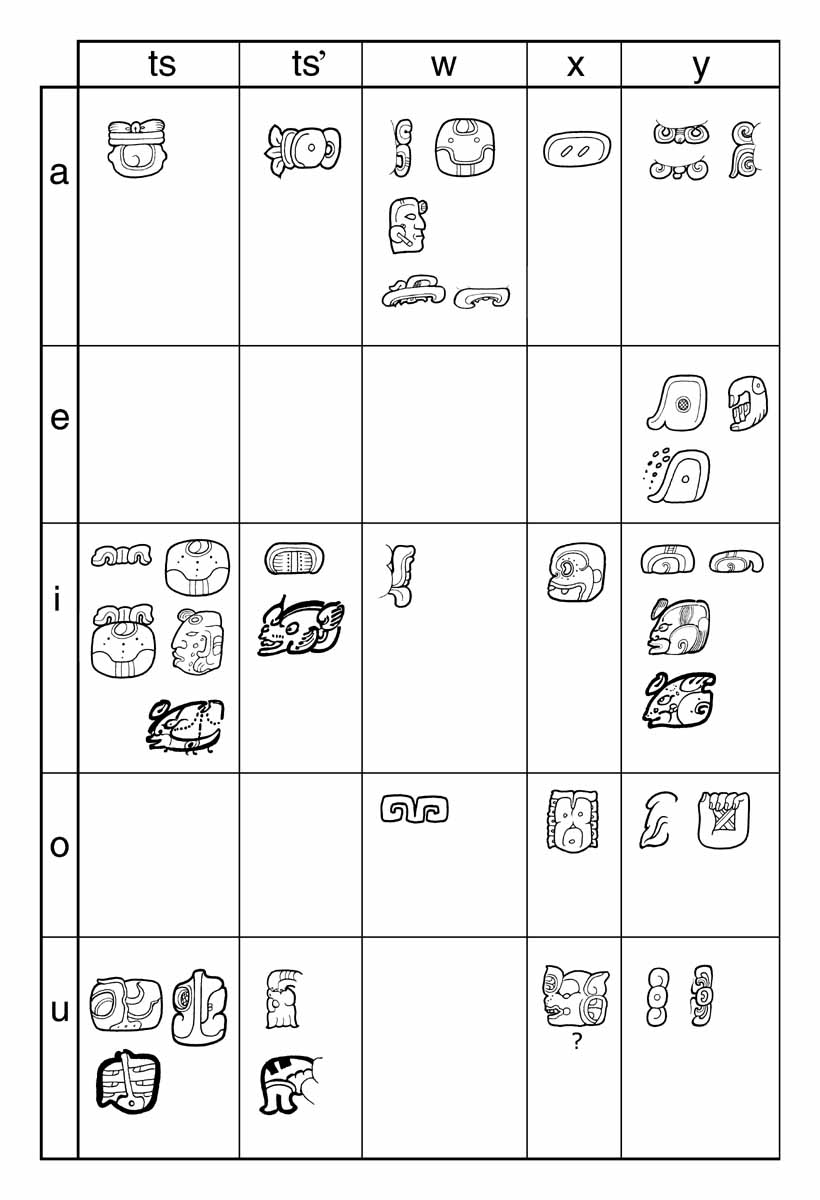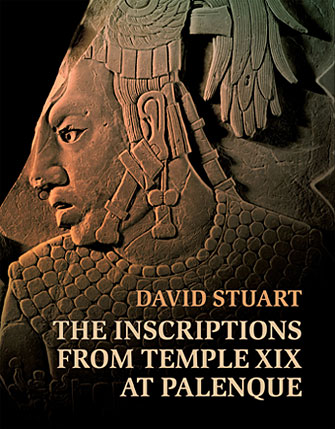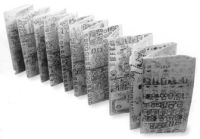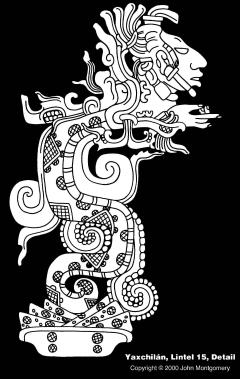Maya Glyph Blog 2010, No. 1: Chichen Itza - The Updated Preliminary Chichen Itza Maya SyllabaryAs first official installment at
Maya Glyph Blog I present the
updated Preliminary Chichen Itza (Yucatan, Mexico) Maya Syllabary; the previous version of the Chichen preliminary syllabary was posted late 2009 at
Mesoweb (section Chichen Itza Resources) and originally was composed for my workshop at the 13th European Maya Conference in Cracow, Poland (November 2009).
The grid used for this syllabary is the same as the syllabary developed by Michael Coe and Mark Van Stone (a slightly adjusted version of their syllabary in "Reading the Maya Glyphs," 2001, Thames & Hudson), as posted online at Mayavase.com, a website maintained by Justin Kerr (clickable in the right hand side nav bar). This makes side-by-side comparison of the site specific and the general all-inclusive syllabary much easier; for instance, if one wants to search for syllabic signs not employed at Chichen Itza or, more appropiately, syllabic signs employed at Chichen Itza only (see
ka4,
k'u3, and
ya3 in the Chichen syllabary). Please take note of the fact that the glyphs as drawn in the Coe & Van Stone syllabary are "polished/idealized" versions of the signs as occurring in their original setting (i.e., on carved monuments, incised objects, or painted ceramic vessels from any part of the Maya area). Many of the Chichen syllabic signs are "imperfect," having suffered some level of erosion.
The updated
Preliminary Chichen Itza Maya Syllabary has been prepared by digitally cutting & pasting single glyph signs from black-and-white line drawings by various artists of the inscriptions at Chichen Itza (among them are Ian Graham, Ruth Krochock, Peter Mathews, Alexander Voss, Elisabeth Wagner, and myself). As such the syllabary represents a specific local style, the style of the scribes and sculptors active at Chichen Itza (nota bene: there remains some level of inaccuracy, the hand of each individual artist that drew the inscriptions). The hardness of the stone used for the monuments at Chichen Itza is the reason of the sometimes rather rough exterior look of many of the inscriptions in comparison to the inscriptions of many Classic Lowland Maya sites. Included are the best preserved examples (most inscriptions at Chichen Itza have survived in reasonable good condition).
This syllabary does not cover or include syllabic signs as found on a variety of portable objects at the Castillo structure or from the Cenote of Sacrifice sink hole, as (most of) these objects are clearly of foreign origin (i.e., Calakmul, Izamal, Palenque, Piedras Negras, Xcalumkin region/Campeche).
Each of the four parts of this syllabary is accompanied by an annotated list of the Classic Maya epigraphic syllable inventory. I present these notes to assist in the identification of all syllabic signs included in the grid. When a box within the grid is occupied by two or more signs, each sign is accompanied by a number (the number is only there for easy reference and does not reveal any other information). For example, for the syllable
'a there are three signs in the box, and these will be referred to as
'a1,
'a2, and
'a3. So-called T-numbers (i.e., T228), as employed in the notes, refer to the signs as cataloged by J. Eric S. Thompson (1962, "A Catalog of Maya Hieroglyphs," University of Oklahoma Press), of which the list of drawings is available at the FAMSI (
Foundation for the Advancement of Mesoamerican Studies, Inc.) website. Occasionally, I also provide my personal ideas on the iconic origin of (some of) these syllabic signs (especially in case of rare or even unique signs).
Future installments at
Maya Glyph Blog will include site specific syllabaries for Ek' Balam, Caracol, Early Tikal, Xcalumkin, and the Dresden Codex (other syllabaries are in preparation; depending on the state of conservation of the local corpus and availability of sufficiently detailed quality drawings). Through the numbering system common and unique syllabic signs can be compared between different site specific syllabaries (using the common three letter site codes established by Ian Graham and extended by Peter Mathews and Berthold Riese; comparing CHN
'a3 to CVS
'a6 [CVS=Coe&Van Stone]). For example, now regional and local differences in paleographic style can be researched. Any future discovery may extend any of the site specific syllabaries and may thus provide additional graphic variants or even new allographs (different graphic signs for the same syllabic value). The fact that a certain syllabic sign (value) is not employed at a certain site may simply indicate that the currently known extant record does not provide a hieroglyphic text that contains a word with that specific syllable (sound combination). Additionally, certain allographs may be region or site specific or even may be employed only in a specific time period.
The inscriptions at Chichen Itza were commissioned between A.D. 832 (Temple of the Hieroglyphic Jambs, West Jamb) and A.D. 998 (High Priest's Grave, Pillar 4), with the majority of inscriptions falling between A.D. 869-890. The most often mentioned individual during this short period was K'ahk' Upakal K'ihnich K'awiil (or simply K'ak' Upakal K'inich K'awil), whose nominal phrase is commonly abbreviated to just K'ahk' Upakal.

The updated
Preliminary Chichen Itza Maya Syllabary, Part 1:
'a-huNB: I prefer to open the "vowel signs" with a glottal stop, /'/ (in contrast to some epigraphers and the original Coe & Van Stone syllabary)
'a - Included are three common signs that represent the syllable
'a at Chichen Itza. Both
'a1 and
'a2 are graphic variants of T228/T229, a common sign for
'a. In
'a3 one may recognize the head of a turtle;
'a3 may thus be derived through a process of acrophony from the noun
'ahk (or perhaps even
'ahkul) "turtle"
'e - The sign
'e is rare at Chichen Itza; this example is employed in the text on the underside of the Temple of the Initial Series Lintel
'i - Both
'i1 and
'i2 are graphic variants of the common sign T679c
'i'o - Both
'o1 and
'o2 are graphic variants of the common sign T280
'o'u - Here I have included a large variety of syllabic signs for
'u. These signs are most commonly employed to write the third person pronoun
u-; as this pronoun occurs rather frequently, Maya scribes (here and everywhere in the Maya area) employed a large selection of different
'u signs. Here
'u1 and
'u2 are graphic variants of the same sign (T513);
'u3 is a (most probably human) head unique to Chichen Itza (perhaps the portrait of a Maize God related Moon Deity; if so, possibly derived from
uj "moon" through a process of acrophony);
'u4 and
'u5 are graphic variants of the same sign (T1, T3);
'u6 and
'u8 are most probably graphic variants of the same sign (possibly two eye-balls, derived from
ut "eye" through a process of acrophony);
'u7 is the Chichen variant of an
'u variant based on a jewel or bead on a belt assemblage or necklace (compare to T232) and probably iconically derived from
uh "jewel; bead" through a process of acrophony
(NB: I prefer /b/ above /b'/ as in the Classic Maya inscriptions there seems to be no contrast between the two phonemes)
ba - For the syllable
ba the scribes employed various slightly different graphic variants of the common sign T501
ba, here included as
ba1 and
ba2. In several Late Classic contexts also T757
BAH can be found employed for
ba;
ba3, as included here, is an eroded version of T757, employed in a collocation
tu-T757
-hi (other texts at Chichen provide
tu-T501
-hi)
be - No text at Chichen Itza has yet been identified that includes a sign for
bebi - The sign
bi2 occurs commonly in the inscriptions, the sign
bi1 occurs only once at Chichen (Casa Colorada). This sign
bi1 (and as such all variants of T764[585]) represents a serpent-head (T764, but with a prominent diamont-shaped and cross-hatched element); it may be derived acrophonically from the verb
bich'- or
bik'- "to zig-zag (like a serpent)." I interpret T585
bi to be iconically derived from T764[585] as a
pars pro toto, a part that represents the whole (as T585 is the most diagnostic part of the T764[585] sign)
bo - No text at Chichen Itza has yet been identified that includes a sign for
bobu - No text at Chichen Itza has yet been identified that includes a sign for
bucha - The signs
cha1,
cha2, and
cha3 are all graphic variants of the common sign T668
cha;
'a4 is the local variant of T142
cha (in the Thompson catalog: upper sign only!)
che - No text at Chichen Itza has yet been identified which includes a sign for che (in my earlier research [e.g., my 2005 dissertation] I identified a
che sign, but at present I interpret this sign as a local variant of
HU'N "knot" employed to spell
hun "1" in the theonym Yax Chit Hun Kan Ajaaw)
chi -
chi1 and
chi2 are but graphic variants of the common T671
chi, an upturned c-shaped hand-sign (see my 2003 essay "The Human Hand in Classic Maya Hieroglyphic Writing," available at Mesoweb.com)
cho -
cho1 and
cho2 are graphic variants of T590b "jawbone" (T568 is the Chichen
cho2 variant); the
cho syllabic sign is derived through a process of acrophony from the Ch'olan noun
cho'h "jawbone"
chu - Perhaps this is the Chichen variant of T601
chu (as such the question mark); only one occurrence (Temple of the Hieroglyphic Jambs, West Jamb)
ch'a - All three signs are graphic variants of T603
ch'a (but having suffered some level of erosion).
ch'a1 and
ch'a2 are reduced through only one sign of T603 due to overlap.
ch'a3 is a less frequent variant of T609, sporting three dotted circular elements (T634)
ch'e - No text at Chichen Itza or the Maya area in general has yet been identified that includes a sign for
ch'e (but in 2006 Yuri Polyukhovich circulated a manuscript in which he tentatively identified a
ch'e sign in a Tonina inscription)
ch'i - No text at Chichen Itza or the Maya area in general has yet been identified that includes a sign for
ch'i (but I should note that some epigraphers are considering T77 [T72, T76, T81] and variants, a possible
k'i syllable, as a
ch'i syllable)
ch'o - This is the common graphic variant at Chichen Itza (compare to T758a). The syllable
ch'o is derived acrophonically from the noun
ch'o'h~
ch'o' "rat"
ch'u - No text at Chichen Itza has yet been identified which includes a sign for
ch'uha -
ha1 and
ha5 are graphic variants of the same sign (the "knot"-sign on top of the skeletal head is absent in
ha1);
ha2 occurs only once (High Priest's Grave, Panel fragment). The signs
ha3 and
ha4 are graphic variants of the same syllabic sign, a sign unique to Chichen Itza (a double infixation of the "percentage" sign as found on the cheek of the skeletal head into the "knot" of the common
ha sign, like
ha5)
he - No text at Chichen Itza has yet been identified that includes a sign for
hehi - Both
hi1 and
hi2 are graphic variants of the common
hi sign (actually just reduced to the top element of the digraph T145e:528
hi sign due to sign overlap). Sign
hi3 only occurs in the text of the High Priest's Grave; this sign was formerly a sign for
ji, but in the Late Classic period (ca. A.D. 750-900) the sounds /h/ (a glottal aspirate or glottal voiced fricative) and /j/ (a velar aspirate or velar voiced fricative) merged and signs that formerly opened with /j-/ (and exclusively were employed in that fashion) were employed to record /-h/ (among other contexts; see Grube 2004 "The Orthographic Distinction between Velar and Glottal Spirants in Maya Hieroglyphic Writing," in
The Linguistics of Maya writing, edited by Søren Wichmann)
ho - No text at Chichen Itza has yet been identified that includes a sign for
hohu - No text at Chichen Itza has yet been identified that includes a sign for
hu
The updated
Preliminary Chichen Itza Maya Syllabary, Part 2:
ja-muja -
ja1 is the Chichen variant of the common T683b "moon-sign" for
ja;
ja2 and
ja3 are "half versions" of this sign, due to overlap by a preceding sign
je -
je1 is the local variant of the common T69 (only lower suffix!)
je; a slightly slanted graphic variant
je2 can also be found at Chichen Itza.
je3 is an abbreviated version, with only two elements and can be found recorded only once (Casa Colorada)
ji - Chichen Itza scribes/sculptors employed three variants of the common T136 (only lower suffix!)
ji. The common variant at Chichen is
ji3; however, also graphic variants with four u-shaped elements (
ji1 &
ji2) and just two (
ji4) were employed
The syllabic variants of
je and
ji can be reduced from four/three elements to just two; as far as my present research shows, scribes/sculptors resisted to reduce these signs any further. This probabably has to do with the fact that reduction is only effective as long as the sign remains easily recognizable.
je reduced to just one element would look too much like a
ma reduced to just one element (which does exist, see CHN
ma1,
ma2). A
ji reduced to just one element would not be recorgnizable as a potential
ji as the single u-shaped element could belong to any sign (or be a reduction of such sign) that employed u-shaped elements (e.g.,
ju,
no,
xo). Reduction of graphic signs always led to a reduction to the most diagnostic part of the original sign (generally through a process of
pars pro toto, "part that represents the whole") and which would be in contrast to other signs
jo - At Chichen at least three different graphic variants of the common T607
jo sign are employed; the difference lies in the fact where the sign has its opening (
jo1 up,
jo2 left,
jo3 down). Rotation, in this and most cases in Maya inscriptions (but not all!), does not alter the value of this sign
ju - Two graphic variants of the same sign, a turtle carapace encircled by u-shaped elements. This
ju sign is a digraph, employing two different graphic signs to arrive at a new sign, in this case
ju. Digraphs (and multigraphs) are the scribe's "instrument" to add new hieroglyphic signs to the inventory when the need arises (as such in the early stage of Maya writing there was no
ju sign). Note that the series of u-shaped elements can fully encircle the turtle carapace or can be reduced to three elements on top
ka -
ka1 and
ka2 are local variants of the common T25 "fish-fin"
ka sign;
ka3 is the actual T738b fish sign for
ka (
kay "fish" acrophonically reduced to
ka) from which
ka1 and
ka2 are ultimately derived (though
pars pro toto, part that represents the whole).
ka4, however, is a completely new
ka sign, occurring only twice in the Casa Colorada text (A.D. 869-873) and once on Las Monjas Lintel 6 (A.D. 880). This sign represents a serpent head and as such
ka3 should be derived from a word for serpent that opens with
k-; in the Yucatecan languages (as well as in proto-Mayan) the word for serpent is
kaan~kan. Through a process of acrophony the word
kaan~kan was reduced to
ka, hence the
ka4 syllabic sign at Chichen Itza. If indeed derived from a Yucatecan word, this would be a clue to the locally spoken language or vernacular at the time the inscriptions were carved (and actually the language/vernacular of the scribes/sculptors involved)
ke - The common sign for
ke (T711)
ki - Three variants for the sign
ki (T102), with slight graphic variation
ko - Two graphic variants for the sign
ko (T110)
ku - Three graphic variants of the common T528
ku sign, in which outer shape was dictated by its location within a collocation
k'a - Two graphic variants of the common hand signs T669
k'a;
k'a1 is a variant of T669a and
k'a2 is a variant of T669b
k'e - A possible local variant of the
k'e sign; however, it only appears in the same nominal phrase (e.g., Temple of the Four Lintels, Lintel 2)
k'i - No text at Chichen Itza has yet been identified that includes a sign for
k'i (see note to
ch'i)
k'o - A possible local variant of the
k'o hand sign (as such the question mark); it only appears in a nominal phrase (Temple of the Four Lintels, Lintel 2)
k'u -
k'u2 is the Chichen variant of T604
k'u;
k'u1 is a variant reduced to just the upper element, most probably due to sign overlap. The sign
k'u3 is the head of a quetzal bird (
k'uk'), normally used as a logogram. However, at Chichen Itza the scribes/sculptors employed it as
k'u (e.g., Temple of the One Lintel), thus a sign acrophonically reduced from
k'uk'la - A large variety of graphic variants for
la was employed at Chichen Itza; most common are variants
la1,
la2,
la3, and
la4. Less common are
la5 (the two elements stacked instead of side-by-side). Rotation of the sign is of importance in this case; T534 is
'AJAW, while T534 (rotated 180 degrees) is
la. Less frequent employed at Chichen Itza is
la7, which actually is a Late Classic rendition of an Early Classic variant of
la (T139). Rare is its reduction to just one element,
la6 (Halakal Lintel, Underside)
le - Two graphic variants of the common T188
le sign
li -
li1 is a zoomorphic sign, among epigraphers referred to as "worm-bird" (as it seems to hold a worm-like element in its beak);
li2 and
li4 are graphic variants of the common T2/T7/T24
li sign;
li4 is a variant of T83
lo - The Chichen variant of the common T580
lo sign
lu -
lu1 and
lu2 are common variants (compare TT586a-c), but
lu3 presents a rare head-variant of the sign. In general, there are not many head-variants present in the inscriptions of Chichen Itza and this rare example is a personified version of a sign commonly not personified (example from Temple of the Four Lintels, Lintel 1, Underside)
ma -
ma1 is a rotated version of
ma2 and both are reduced versions of
ma4, a graphic variant of T71/T74
ma.
ma3 is a graphic variant of T142
ma (lower suffix only!), but lacking the cross-hatching (all these signs are actually graphically reduced from a multigraphic sign for
ma, T74:617var:142; graphic reduction due to overlap and to its most diagnostic element[s]).
ma5 and
ma6 are the Chichen variant of the common T502
ma sign; this sign is a digraph, as it employs T533/T534 as an infix to T501 (the "template" to several signs, e.g.
HA',
t'u). Digraphs came into existence when either a new syllabic (or logographic) value needed to be represented or when scribes/sculptors invented a new allograph for a common sign (T71/74 and T268 are common versions of
ma)
me - The T761a "penis" sign is commonly employed as a logogram
'AT in Classic Maya texts (or perhaps
'ACH at Chichen Itza; see Boot 2005, dissertation). However, this particular example at Chichen Itza seems to be employed as a syllabic sign and may represent the value
me. The sign is comparable to the sign for "m" (pronounced
e-me in Spanish) in the Landa alphabet (a series of syllabic signs in alphbetic order, in which the hieroglyphic signs approximate the sixteenth century pronunciation of the Spanish letters). The value
me may be derived from a noun
mehen (a common word for "male son of father"), which is (also) a metaphorical expression for "semen" in colonial Yucatec Maya (perhaps in other Mayan languages as well)
mi - The common sign for
mi (T163/T173)
mo - The common sign for
mo (T582; central element at Chichen Itza covered by infixed sign). It only occurs once at Chichen Itza, in the spelling of the month name
mol (
mo[
lo]) (High Priest's Grave, Pillar 4) (another example can be found at Chichen, on a jade pendant from Palenque as found at the Cenote, also in a spelling
mo[
lo])
mu - Common signs for
mu (T19) (this sign is a syllabic sign reduced from the small infixed sign into T644b, unfortunately not individually cataloged by Thompson; only the small curl element remained [again through
pars pro toto])

The updated
Preliminary Chichen Itza Maya Syllabary, Part 3:
na-t'una -
na1 and
na4 are graphic variants of the common T23
na sign.
na2 is a more elaborate portrait version of T537
na; it is the frontal view of a human head with the eyes closed.
na3 is also a human head with a closed eye, but now in profile (T1052a;
na2 and
na3 may thus just be graphic variants due to a switch of front-to-profile depiction)
ne - No text at Chichen Itza has yet been identified that includes a sign for
neni - Common graphic variants of the T116
ni sign
no - No text at Chichen Itza has yet been identified which includes a sign for
no (but a small jade fragment from the Castillo, of foreign origin as it most probably came from Calakmul, contains the spelling
yu[
ku]
no-ma)
nu -
nu1 and
nu2 are but graphic variants of the same sign (
nu1 with a cartouche around);
nu3 seems to be an allograph (but all three signs may be derived from one original
nu sign)
pa - Two variants of the common T586/T602
pa sign
pe - Two variants of T759 sign, which may have the value
pe (this proposal by Dmitri Beliaev and Albert Davletshin is still under review), as such the query
pi -
pi2 is the full form of
pi;
pi1 is a reduced version (due to overlap). Also
pi3 is a reduced version, in this case the arch or bridge element has been eliminated
po - Perhaps this is a Chichen Itza graphic variant for
po, as such the query (Temple of the Hieroglyphic Jambs, East Jamb)
pu - Two graphic variants for
pu;
pu1 was partly covered by its the succeeding sign (example from the Akab Dzib Lintel, Front)
p'a - No text at Chichen Itza (or the Maya area in general) has yet been identified that includes a sign for
p'ap'e - No text at Chichen Itza (or the Maya area in general) has yet been identified that includes a sign for
p'ep'i - No text at Chichen Itza (or the Maya area in general) has yet been identified that includes a sign for
p'ip'o - No text at Chichen Itza (or the Maya area in general) has yet been identified that includes a sign for
p'op'u - No text at Chichen Itza (or the Maya area in general) has yet been identified that includes a sign for
p'usa - Two graphic variants of the
sa sign can be identified at Chichen Itza
se - No text at Chichen Itza has yet been identified that includes a sign for
sesi - Three graphic variants of the common sign T57
siso - No text at Chichen Itza has yet been identified that includes a sign for
sosu - Two graphic variants of the sign for
suta - Like the pronoun
u-, also the preposition
ta occurs frequently at Chichen Itza. To represent this word various syllabic signs were employed.
ta1 is the local variant of the common sign T53
ta;
ta2 and
ta4 are local variants of T103 (do not include the fourth suffix in the Thompson catalog, that is a codical sign for
ki)
te - Two graphic variants of the sign
te.
te1 occurs in the text on the Monjas Annex lintel (front);
te2 is employed at the Monjas structure (Lintel 3)
ti -
ti1 and
ti2 are graphic variants of the common sign T59
ti;
ti3 seems to be the head of a King vulture (
Sarcoramphus papa, a bird resident to the area of southern Mexico to northern Argentina). Perhaps, and only perhaps, T59
ti is a
pars pro toto of the King vulture variant for
ti (just employing the "
ti-envisioned" fleshy caruncle or protuberance on its beak)
to -
to1 and
to2 represent a common sign, they are local graphic variants of T138. T138 is a reduced version of T138:563b
to (probably due to overlap, and ultimately employed as a sign apart)
tu -
tu1,
tu2, and
tu3 are three graphic variants of the common sign T92
tut'a - Possibly this is a syllable for
t'a, as first proposed by Elisabeth Wagner in 199o's, to be found in a spelling
t'a?
-ba (Tomb of Unknown Location, Capstone)
t'e - No text at Chichen Itza (or the Maya area in general) has yet been identified that includes a sign for
t'et'i - No text at Chichen Itza (or the Maya area in general) has yet been identified that includes a sign for
t'it'o - Possibly this variant of T174 represents the value
t'o; this sign, possibly abbreviated due to overlap (the full sign being T174:SHELL), occurs only once at Chichen Itza (Temple of the Hieroglyphic Jambs, West Jamb), is still under review (as such the question mark)
t'u - No text at Chichen Itza has yet been identified that includes a sign for [T528]501
t'u
The updated
Preliminary Chichen Itza Maya Syllabary, Part 4:
tza-yutza - Two local variants of T699
tza;
tza1 from the Caracol Panel and
tza2 from the Caracol Circular Stone
tze - No text at Chichen Itza has yet been identified that includes a sign for
tzetzi -
tzi1 and
tzi2 are local graphic variants of the common sign T507a
tzitzo - No text at Chichen Itza has yet been identified that includes a sign for
tzotzu - A single example for
tzu at Chichen Itza (Yula, Lintel 1, Underside); and it is a head variant (a.k.a. a personified variant or form)
tz'a - Local variant of
tz'a (compare to T356), but missing its central po shaped element due to sign overlap
tz'e - No text at Chichen Itza has yet been identified that includes a sign for
tz'etz'i - Two graphic variants of the common sign T263
tz'itz'o - No text at Chichen Itza has yet been identified that includes a sign for
tz'otz'u - No text at Chichen Itza has yet been identified that includes a sign for
tz'uwa -
wa1 and
wa2 are graphic variants of the common sign T130
wa;
wa3 is a rare sign for
wa, a human head looking to the right
we - No text at Chichen Itza (or in the Maya area in general) has yet been identified that includes a sign for
wewi - Two graphic variants for
wi (T117);
wi1 is less well preserved than
wi2
wo - Two graphic variants for
wo (T67)
wu - No text at Chichen Itza (or in the Maya area in general) has yet been identified that includes a sign for
wu (but a sign graphically close to T285 and employed as superfix may be a candidate for either
wu or
hu in collocations as
wu?/
hu?
-EYE)
xa - No text at Chichen Itza has yet been identified that includes a sign for
xaxe - No text at Chichen Itza has yet been identified that includes a sign for
xexi - No text at Chichen Itza has yet been identified that includes a sign for
xi (an incised bone fragment of unknown but most probably foreign provenance and found at the Cenote sink hole contains a
xi sign in a collocation spelling
'AJ-k'i?
-xi-ma)
xo - This sign
xo only occurs once at Chichen Itza (Halakal Lintel, Underside); it is partially overlapped by other signs
xu - Two graphic variants of the T756a-b, possibly employed as syllabic sign
xu (still under review, as such the query; see Boot 2009, "The Bat Sign in Maya Hieroglyphic Writing: Some Notes and Suggestions, Based on Examples on Late Classic Ceramics," available at Mayavase.com)
ya -
ya1,
ya2, and
ya5 are graphic variants of the common sign T126
ya. The graphic difference is in the central element, either three small round elements (in descending size), a u-shaped element, or a more squeezed u-shaped element.
ya4 is a reduced
ya5 sign, with one of the halves reduced and as such still recognizable as a reduced variant of ya5. The scribes developed a new sign for
ya at Chichen Itza, a human head with a band over the length of the head, ya3 (this sign was cataloged T1051 by Thompson). It occurs in slightly different graphic variants in the hieroglyphic text at the Casa Colorada
ye - Graphic variant of the common sign for
ye (T710 & T220; only the first two signs in the Thompson catalog); only occurs once at Chichen Itza (Casa Colorada)
yi - Three graphic variants of the common sign for
yi (T18)
yo - Chichen scribes/sculptors employed two
yo allomorphs.
yo1 and
yo2 (a clenched fist with crossed bands, with
yo1 the left hand and
yo2 the right hand version) are graphic variants of T673
yo;
yo3 is a graphic variant of T115
yo. At Chichen Itza these
yo signs are employed in completely different word domains.
yo1/
yo2 in
yo-to-ti/
yo-TOT and
yo-ko spellings, while
yo3 is employed in a
yo-'OL-la and two
yo-'OTOT spellings (all Temple of the Hieroglyphic Jambs)
yu - Two graphic variants of the common sign T61
yuThis concludes the annotated overview of the updated
Preliminary Chichen Itza Maya Syllabary. More graphic variants could have been included, but the present selection of signs provides a good overview of the syllabic inventory at the site as employed by Chichen scribes/sculptors. This syllabary furthermore provides insight into the evolution of Maya writing, as the syllabary here assembled was employed in only a relative short period in the Late Classic period
First edit: May 18, 2010. Last edit: May 30, 2010

















